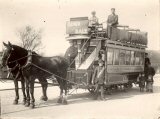
South Shields Horse-drawn Tram
From 1887 to 1906, South Shields Tramways were horse powered.
|
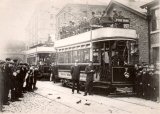
South Shields Trams Nos. 4 & 7, Tyne Dock
Pictured at the opening of the route to Tyne Dock, June 23rd 1906.
|
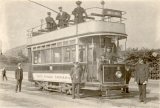
South Shields Tram No. 5, Pier Head
The initial batch of 10 trams were built by Hurst Nelson of Motherwell.
|

South Shields Tram No. 2
|
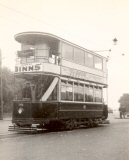
South Shields Tram No. 28, Pier Head Terminus
On the Tyne Dock via Market route. Many South Shields trams, in common with those of Newcastle, Gateshead & Sunderland urged people to "Shop At Binns". Pictured in 1934.
|
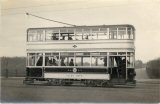
South Shields Tram No. 49 "Caer Urfa"
Several South Shields trams carried names between 1929 and 1934. Caer Urfa was the Roman name for South Shields. Before rebuilding and naming in 1929, this tram ran as No. 29.
|
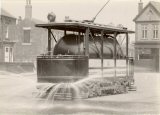
South Shields Water Car
Built in 1913, with a tank to hold 2000 gallons of water.
|
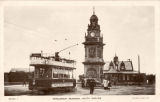
South Shields Tram No. 16, Pier Head Terminus, 1934
The Pier Head terminus was adjacent to the memorial to the inventors of the lifeboat, William Wouldhave and Henry Greathead. Postcard by Rotary [10.721 1]
|
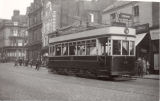
South Shields Tram No. 46, Fowler Street, September 1933
This tram was originally Tyneside Tramways & Tramroads No. 3, and ran on that system from 1901 until its demise in 1930. Shortly after this photograph was taken it was converted to a single decker, and the headlight was moved to a more conventional position. Photograph by M.J. O'Connor
|
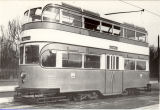
South Shields Tram No. 52
The last tram built for South Shields Corporation Tramways was this modern streamliner with a centre entrance. Costing £2500 in 1936, it was sold to Sunderland for £250 in 1946 after the closure of the South Shields system, where it ran as No. 48 until 1954.
|
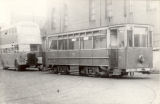
South Shields Tram No. 43 awaiting scrapping, 1946
With the closure of the South Shields tramway system, and the conversion of its routes to trolley buses, the Corporation attempted to sell off its remaining trams without success, apart from No. 52. This double decker built by English Electric in 1921 has already lost its top deck. The motors from this tram were sold to Gateshead. Photograph by George Hearse
|
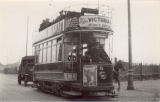
Jarrow Tram No. 9, Swinburne Street, about 1927
The Jarrow system connected with the South Shields tramways at Tyne Dock, and operated from 1906 to 1929.
|
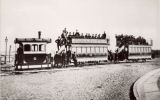
Sunderland Steam Tram No. 1, 1880
Whilst Gateshead operated steam trams from 1883 to 1901, and Tynemouth And District was steam powered between 1890 and 1900, Sunderland quickly abandoned its attempts to use this method of propulsion, and stuck with horse drawn trams until 1900
|

Opening of Sunderland electric tramway, 15th August 1900
Following a lunch at the Town Hall, Councillor Trewhitt, Chairman of the Tramways Committe drove tram No. 1 to Christ Church, followed by six other trams. After this they travelled to Roker, then back to the Town Hall. The cars were decorated with ivy and nasturtium leaves for this opening ceremony. The original trams did not have headlamps and carried revolving destination indicators which showed "Roker", "High Street", "Christ Church" or "Circular".
|
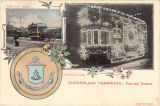
Sunderland Tramways: Past And Present
This postcard by Hills of Sunderland was posted to Leeds in February 1904, and contrasts the old horse drawn trams with an illuminated electric tram bearing the Sunderland Coat of Arms and motto "Nil Desperandum Auspice Deo". The headboard on the tram reads "Sunderland Leads"
|
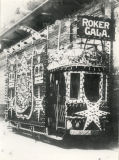
Illuminated Tram, Roker Gala
Possibly the same tram as in the previous postcard
|
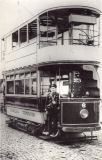
Sunderland Tram No. 6
Built in 1900, this tram was renumbered as No. 46 in 1938, shortly before being withdrawn, as its original number was required for a tram bought second-hand from Ilford.
|
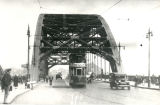
Sunderland Tram No. 34, Wearmouth Bridge
The new bridge opened in 1929, but because of the way it was constructed around the existing bridge, the disruption to the tram service was minimal.
|
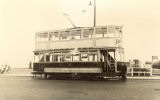
Sunderland Tram, Seaburn
Before the adoption of pantographs, the old trolley poles were replaced by bow collectors as seen here.
|
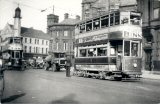
Sunderland Trams Nos. 32 & 44, 1932
Both of these trams were built in 1901. In 1938 No. 32 was renumbered as 43, its original number being given to a tram purchased from Huddersfield. Photo by M.J. O'Connor.
|
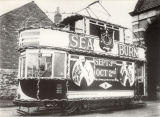
Sunderland Tram No. 61, decorated for Seaburn event
This tram was originally built in 1902 as an open top double decker. In 1934 it was rebuilt with a small enclosed upper saloon, and quickly dubbed "The Ice Box".
|
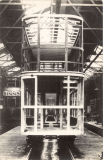
Sunderland Tram under construction, 1933
After 1930, neither Newcastle or Gateshead built any new trams, South Shields built just one, Sunderland however built or purchased another 24 new trams. Nos. 96-98 were built at Sunderland Corporation's Hylton Road depot in 1933.
|
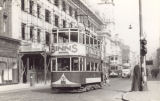
Sunderland Tram No. 97, Fawcett Street
Sunderland were the first tramway to adopt pantographs for current collection. The majority of Sunderland trams carried adverts on the front and rear urging people to "Shop At Binns". Photograph by W.J. Haynes
|
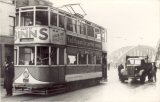
Sunderland Tram No. 87, Bridge Street
No. 87 was built by English Electric in 1933 and spent most of its working life on the Durham Road route, not being withdrawn until the end of the service in October 1954.
|

Sunderland Tram No. 89, September 10th 1952
Photograph by R.J.S. Wiseman
|
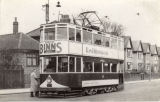
Sunderland Tram No. 90
Photograph by W.J. Haynes
|
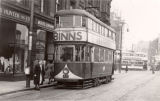
Sunderland Tram No. 45
As many tramway systems closed during the 1930s and 40s, Sunderland found a cheap way of replacing its aging stock with often quite modern trams. Originally built for Portsmouth Corporation in 1930, this tram was purchased by Sunderland in 1936 and numbered 52. When a new streamlined tram was given that number in 1940, this tram was renumbered as 45. It was withdrawn from service in 1953.
|
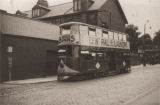
Sunderland Tram No. 100, Vilette Road.
Originally built for London Transport in 1930, this tram was purchased by Sunderland in 1937. Seen here shortly after the war, it still retains its wartime livery, and has had the name "Sunderland" painted out to confuse German spies!. Withdrawn in 1951, this tram has been preserved at the tramway museum at Crich. Photograph by R.R. Clark
|
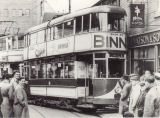
Sunderland Tram No. 41, derailed, Hylton Road
This ex-Manchester "Pilcher" tram has drawn a crowd as it has left the track and ended up next to Frederick J. Watson & Sons Ironmongers store.
|
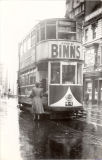
Sunderland Tram No. 44, Bridge Street, September 11th 1952
Built by Dick, Kerr & Co. in 1901 as an open topped double decker, this tram later received a balcony cover, a windscreen, and finally was rebuilt in 1930 as a totally enclosed car. It was withdrawn in 1953. Photograph by R.J.S. Wiseman
|
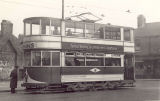
Sunderland Tram No. 8
On Dene Lane in Fulwell on the route to Durham Road, this former Ilford tram passes the end of Sea Road. Photograph by Robert F. Mack
|
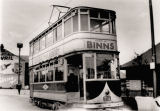
Sunderland Tram No. 73, Grangetown Terminus, July 2nd 1941
Built for Sunderland by English Electric in 1921, this tram survived until June 1953. Photograph by J.C. Gillham
|
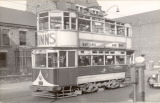
Sunderland Tram No. 71, Wheat Sheaf Junction, October 9th 1953
Photograph by J.C. Gillham
|
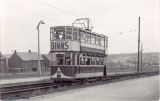
Sunderland Tram No. 25, Durham Road, June 25th 1952
Whilst most other tram systems were being dismantled, Sunderland carried on expanding. The final extension on reserved track along Durham Road was opened in stages between 1947 and 1949. The Photograph by John H. Meredith
|
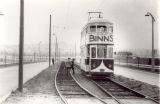
Sunderland Tram No. 26, Durham Road, April 28th 1950
No. 26 was known as the "Ghost Tram", partly because of its quiet running, but also because of the secrecy involved in its construction at Hylton Road in 1932. Photograph by R.R. Clark
|

Sunderland Tram No. 94, Durham Road Terminus, September 10th 1952
The terminus near the Borough boundary at the end of the Durham Road extension was the most distant part of Sunderland's 13.75 mile tramway system. It was closed in March 1954, only five years after being opened.
|

Sunderland Tram No. 34, Seaburn
Built for Huddersfield in 1932 and purchased by Sunderland in 1938. This was one of the trams which took part in the final procession when the Sunderland system was closed on October 1st 1954. Photograph by Robert F. Mack
|
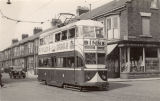
Sunderland Tram No. 51
Built in Sunderland in 1938, this was the penultimate tram in the Sunderland fleet (the final tram, no. 52 followed in 1940). With a centre entrance and streamlined layout, this was the most advanced design in service on the system.
|